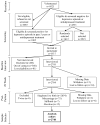Clinical correlates of prescription opioid analgesic use in pregnancy
- PMID: 24951127
- PMCID: PMC4272915
- DOI: 10.1007/s10995-014-1536-6
Clinical correlates of prescription opioid analgesic use in pregnancy
Abstract
A 2012 committee opinion from the American College of Obstetricians and Gynecologists highlights the considerable increase in opioid addiction in recent years, yet little is known about clinical correlates of prescribed opioids among pregnant women. This study examines clinical and demographic factors associated with the use of opioid analgesics in pregnancy. Data were derived from a prospective cohort study of pregnant women. Participants were administered the Composite International Diagnostic Interview to identify depressive and anxiety disorders and data on medication use were gathered at three assessment points and classified according to the Anatomical Therapeutic Chemical Code (ATC) classification system ATC group N02A. Participants included 2,748 English or Spanish speaking pregnant women. Six percent (n = 165) of women used opioid analgesics at any point in pregnancy. More pregnant women using opioids met diagnostic criteria for major depressive disorder (16 vs. 8 % for non users), generalized anxiety disorder (18 vs. 9 % for non users), post-traumatic stress disorder (11 vs. 4 % for non users) and panic disorder (6 vs. 4 % for non users). Women who reported opioid use were also significantly more likely than non users to report using illicit drugs and almost three times as likely to report smoking cigarettes in the second or third trimester of pregnancy (4 and 23 %, respectively) as compared to non-opioid users (0.5 and 8 %). The use of opioids in pregnancy was associated with higher levels of psychiatric comorbidity and use of other substances as compared to non-opioid users.
Conflict of interest statement
Figures
Similar articles
-
Regular use of prescribed opioids: association with common psychiatric disorders.Pain. 2005 Dec 15;119(1-3):95-103. doi: 10.1016/j.pain.2005.09.020. Epub 2005 Nov 17. Pain. 2005. PMID: 16298066
-
Association between mental health disorders, problem drug use, and regular prescription opioid use.Arch Intern Med. 2006 Oct 23;166(19):2087-93. doi: 10.1001/archinte.166.19.2087. Arch Intern Med. 2006. PMID: 17060538
-
Association of mental health disorders with prescription opioids and high-risk opioid use in US veterans of Iraq and Afghanistan.JAMA. 2012 Mar 7;307(9):940-7. doi: 10.1001/jama.2012.234. JAMA. 2012. PMID: 22396516
-
What percentage of chronic nonmalignant pain patients exposed to chronic opioid analgesic therapy develop abuse/addiction and/or aberrant drug-related behaviors? A structured evidence-based review.Pain Med. 2008 May-Jun;9(4):444-59. doi: 10.1111/j.1526-4637.2007.00370.x. Pain Med. 2008. PMID: 18489635 Review.
-
Opioid prescription patterns in Germany and the global opioid epidemic: Systematic review of available evidence.PLoS One. 2019 Aug 28;14(8):e0221153. doi: 10.1371/journal.pone.0221153. eCollection 2019. PLoS One. 2019. PMID: 31461466 Free PMC article.
Cited by
-
Comparison of the cohort selection performance of Australian Medicines Terminology to Anatomical Therapeutic Chemical mappings.J Am Med Inform Assoc. 2019 Nov 1;26(11):1237-1246. doi: 10.1093/jamia/ocz143. J Am Med Inform Assoc. 2019. PMID: 31545380 Free PMC article.
-
Mental Health of Mothers of Infants with Neonatal Abstinence Syndrome and Prenatal Opioid Exposure.Matern Child Health J. 2018 Jun;22(6):841-848. doi: 10.1007/s10995-018-2457-6. Matern Child Health J. 2018. PMID: 29417369
-
Prescription opioid use during pregnancy and risk for preterm birth or term low birthweight.J Opioid Manag. 2021 May-Jun;17(3):215-225. doi: 10.5055/jom.2021.0632. J Opioid Manag. 2021. PMID: 34259333 Free PMC article.
-
Timing of treatment for opioid use disorder among birthing people.J Subst Use Addict Treat. 2024 Jun;161:209289. doi: 10.1016/j.josat.2024.209289. Epub 2024 Jan 24. J Subst Use Addict Treat. 2024. PMID: 38272119 Free PMC article.
-
Adverse Maternal Experiences and Neonatal Abstinence Syndrome.Matern Child Health J. 2023 Mar;27(3):497-507. doi: 10.1007/s10995-022-03577-1. Epub 2023 Jan 2. Matern Child Health J. 2023. PMID: 36592279 Free PMC article.
References
-
- National Center on Addiction and Substance Use. Controlled prescription drug abuse at epidemic level. J Pain Palliat Care Pharmacother. 2006;20:61–4. - PubMed
-
- Becker W, Sullivan L, Tetrault J, Desai R, Fiellin D. Non-medical use, abuse and dependence on prescription opioids among U.S. adults: Psychiatric, medical and substance use correlates. Drug Alcohol Depend. 2008;94(1–3):38–47. - PubMed
-
- Compton W, Volkow N. Major increases in opioid analgesic abuse in the United States: concerns and strategies. Drug Alcohol Depend. 2006;81:103–7. - PubMed
-
- Compton W, Volkow N. Abuse of prescription drugs and the risk of addiction. Drug Alcohol Depend. 2006;83S:S4–S7. - PubMed
-
- Kuehn B. Opioid prescriptions soar: Increase in legitimate use as well as abuse. JAMA. 2007;297(3):249–51. - PubMed
Publication types
MeSH terms
Substances
Grants and funding
LinkOut - more resources
Full Text Sources
Other Literature Sources
Medical
Research Materials
Miscellaneous


